Table of Contents: How to Grow Grapes
- Choosing the Right Cultivars
- Selecting the Perfect Site
- Planting the Grapevines
- Watering the Grapevines
- Pruning Grapevines
- Trellising and Training
- Common Grapevine Pest
- Common Grapevine Diseases
- Harvesting Your Grapes
How to Grow Grapes
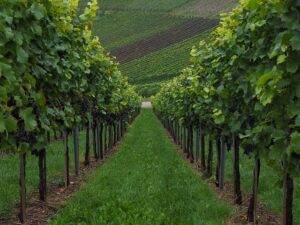
Growing grapes requires the right cultivar, the right spot for planting and the right care. Did you know a single table grape vine can produce 15-30 pounds of grapes a season? If your goal is to make wine, wine grape vines only produce about 12 pounds. This may make 2-3 bottles of wine. Plant accordingly! Either way, if you want to learn how to grow grapes in your backyard so you can enjoy this fruit as a table grape or in winemaking this article is for you.
Choosing the Right Cultivars
The cultivars of grapes you choose will largely depend on the specific conditions of your vineyard and your growing purpose. Do you want to enjoy grapes fresh or do you want to make wine? Do you live in Zone 3 or Zone 9? Answering these questions will help you choose the right cultivar.
- Vitis vinifera ‘Chardonnay’ and ‘Cabernet Sauvignon’: This versatile cultivar thrives in a range of climates, from the cool regions of Champagne, France, to the warmer California regions in the USA. It’s primarily used for white wine production. Vitis vinifera is the primary species used for wine-making and is best suited for USDA hardiness zones 7-10. It includes varieties like Cabernet Sauvignon and Chardonnay. Mature vines can reach heights of 15-20 feet.
- Vitis labrusca ‘Concord’: Native to the Eastern United States, this cultivar produces grapes that are commonly used for jellies, juices, and some wines. It is known for its ability to withstand cold temperatures. Vitis labrusca, often used for table grapes and juices like the Concord grape, performs well in cooler climates, specifically in USDA zones 5-8. When fully matured, these vines can grow up to 15-20 feet tall.
- Vitis rotundifolia ‘Muscadine’: This cultivar is native to the southeastern United States and is resistant to pests and diseases. The grapes are used to make wines, jellies and sauces. Vitis rotundifolia, also known as the Muscadine grape, is adapted to the heat and humidity of the southern United States, thriving in USDA zones 7-10. These grapes can grow up to 20 feet high at maturity.
- Vitis riparia, also known as the River Grape, is native to North America, particularly thriving along riverbanks and in damp, wooded areas. This hardy species is well-suited to colder environments, growing optimally in USDA hardiness zones 2-7. Vitis riparia grapes are often used for winemaking, particularly for ice wine due to their high tolerance for extreme cold. When fully grown, these vines can reach a height of up to 50 feet.-
- Edelweiss: Vitis labrusca ‘Edelweiss’: Originally developed in the University of Minnesota, this cultivar is known for its cold-hardiness and early ripening. Edelweiss grapes are typically used to produce sweet white wines, and due to their adaptability, they thrive in USDA hardiness zones 4-7. When fully mature, Edelweiss vines can reach heights of 10 to 15 feet.
- Reliance: Vitis ‘Reliance’: The Reliance grape cultivar is scientifically known as Vitis ‘Reliance’. This grape variety is especially appreciated for its hardiness, with optimal growth in USDA zones 4–8. The Reliance grape is seedless and yields a beautiful pink table grape that is popular for its sweet and juicy flavor. This grapevine has the potential to grow up to 20 feet at maturity, showcasing its robustness and adaptability.
- Seibel: This hybrid variety of grape, scientifically known as Vitis ‘Seibel’, is renowned for its cold-hardiness and its use in winemaking. Seibel grapes were created by French viticulturist Albert Seibel, who sought to produce a grape robust enough to resist phylloxera, a pest that had devastated European vineyards in the late 19th century. Suited to cooler climates, these grapes flourish in USDA hardiness zones 3-7, depending on the specific cultivar. Seibel grapes often produce wines with unique, complex flavors, and the vine can grow up to 15-20 feet in optimal conditions.
- Swenson Red: Vitis ‘Swenson Red’: The Swenson Red is a grape cultivar that has been bred for hardiness in colder climates, thriving in USDA zones 4-8. This variety is appreciated for its distinctively sweet, red table grapes, which have a robust flavor profile that delights the palate. The Swenson Red grapevine, developed by the master grape breeder Elmer Swenson, exhibits a vigorous growth habit, with vines capable of reaching impressive heights at maturity. This resilience, combined with the grape’s appealing taste, make it a popular choice for vineyards in cooler regions.
- Magnolia: Vitis ‘Magnolia’: The Magnolia grape is a white muscadine variety that is well-known for its sweet flavor profile. This grape is usually used in the production of dessert wines due to the high sugar levels it retains at maturity. It thrives in warmer climates and is optimal for growth in USDA hardiness zones 7-9. Magnolia grapes are often harvested late in the season, allowing them to develop their characteristic sweetness. The vines themselves are robust and exhibit a strong growth pattern. The ‘Magnolia’ cultivar is highly appreciated for both its wine production capabilities and the pleasing taste of its grapes when eaten fresh.
- Valiant: Vitis ‘Valiant’: The Valiant is an extremely hardy grape variety, able to withstand even freezing temperatures of Zone 2. This cultivar, developed at South Dakota State University, is renowned for its resilience and adaptability, thriving in climates where other grapes would struggle to survive. The grapes of the Valiant vine are small to medium in size, blue-purple in color, and are typically consumed fresh due to their sweet, pleasant flavor. The vine exhibits a robust growth habit, capable of reaching significant heights at maturity. With its inherent hardiness and enjoyable taste, the Valiant grape becomes an excellent choice for vineyards situated in colder regions.
Understanding the growth zones and mature sizes of each cultivar is crucial for successful grape cultivation and will guide you in selecting the best cultivars for your vineyard.
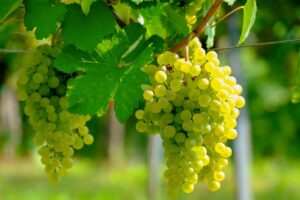
Cultivars very frost tolerant
- Frontenac: Vitis ‘Frontenac’: Developed at the University of Minnesota, the Frontenac grape is a versatile variety that can withstand the rigors of cold climate viticulture, including freezing temperatures. This cultivar produces grapes that possess a deep, garnet color and a rich, cherry aroma, making them perfect for crafting full-bodied red wines. The Frontenac vine is recognized for its vigorous growth and high disease resistance, which further contribute to its suitability for colder regions.
- Marquette: Vitis ‘Marquette’: Also developed at the University of Minnesota, Marquette is a red wine grape variety renowned for its cold hardiness and disease resistance. The grapes of this vine are characterized by complex flavors with notes of cherry, berry, and spice. The Marquette cultivar is capable of thriving in climates with freezing temperatures, making it an excellent choice for growers in colder wine region
Cultivars heat and humidity tolerant
- Black Spanish: Vitis ‘Black Spanish’: Originally from the Mediterranean region, Black Spanish, also known as Lenoir, is a grape variety known for its heat and humidity tolerance. The grapes are dark-skinned, high in acid, and have a strong, fruity flavor. This cultivar is particularly suited for producing red wines and ports. The Black Spanish vine is incredibly hardy, resistant to many common grape diseases, and thrives in warmer climates, making it a popular choice for vineyards in southern regions.
- Muscadine: Vitis rotundifolia ‘Muscadine’: Native to the southeastern United States, Muscadine is a species of grape perfectly adapted to the heat and humidity of its home region. The grapes are large, round, and vary in color from green to bronze to purple-black. Muscadine grapes are known for their unique flavor, usually used to make sweet wines, jams, and jellies. Muscadine vines are also highly disease-resistant and capable of producing fruit in hot, humid conditions, making it an excellent cultivar for warmer climates.

Selecting the Perfect Site
Choosing the perfect location for your vineyard is a critical factor in the success of your grape cultivation. Look for a sunny location as grapevines need full sun(6-8 hours) for most of the day to produce the sweetest grapes. The chosen site should also have well-draining soil to prevent waterlogging which could potentially harm the vines. Grape vines can live for decades so you want to be sure you plant where you are sure you want them.
Keep in mind, grapevines are climbing plants, hence, they require a support system in form of a trellis or arbor to grow properly. Ensure that the selected site can accommodate these structures. The support not only helps in growth but also makes it easier to harvest the grapes while reducing the risk of disease by improving air circulation among the vines.
Essential Soil Requirements
Type of Grape Variety and Target Soil pH
Different grape varieties have distinct soil pH preferences that can significantly influence their growth and fruit production.
- Cabernet Sauvignon: This grape variety prefers a soil pH of around 6.0 to 6.5. The well-drained, gravelly soils with pH within this range bring out the best in Cabernet Sauvignon, resulting in rich, complex wines with unique flavor profiles.
- Merlot: Merlot thrives in slightly acidic soils, with the optimal soil pH ranging from 5.5 to 6.0. Soils with this pH level enhance the development of the grape’s soft, fruity flavors.
- Chenin Blanc: Ideal soil pH for Chenin Blanc is around 6.0. The grapevine does particularly well in deep, cool soils with this level of acidity, which allows it to produce wines with high acidity and excellent aging potential.
- Muscadine: Muscadine grapes prefer a slightly more acidic environment, requiring a soil pH between 5.5 and 6.5. This grape variety’s resilience and adaptability allow it to thrive even in less than ideal soil conditions.
- Reliance: Vitis ‘Reliance’ is a cold-hardy grape variety that prefers a soil pH between 6.0 and 6.5. These sweet, pink grapes grow well in areas with short growing seasons and cooler climates.
- Vitis labrusca ‘Concord’: Concord grapes thrive in well-drained soils with a pH level between 5.0 and 6.0. This grape variety produces bold, full-bodied wines that are known for their intense flavor and aroma.
Remember that soil pH is a crucial aspect of soil health and fertility. It can affect the availability of essential nutrients in the soil and the grapevine’s ability to absorb them, ultimately influencing the quality of the grapes and the wine they produce. Regular soil testing can help ensure that the soil pH remains at optimal levels for your chosen grape variety.
Choosing the Right Soil Type for Your Grapevine
Apart from soil pH, another essential factor to consider is the type of soil. Each soil type has its unique characteristics that can affect the growth and development of grapevines. Some common types of soil used for growing grapes include:
- Sandy Soil: This type of soil is composed of large particles, making it well-draining and relatively acidic. Sandy soils are suitable for growing many varieties of grapes, including Chardonnay, Merlot, and Cabernet Sauvignon.
- Clay Soil: Clay soils are composed of tiny particles that hold water and nutrients well. However, they can become compacted, making it difficult for grapevines to grow and thrive. Cabernet Franc and Malbec are two varieties that perform well in clay soil.
- Loamy Soil: Loamy soil is a mix of sand, silt, and clay, providing a good balance of drainage and water retention. This type of soil is ideal for growing many grape varieties, including Pinot Noir and Riesling.
It’s essential to note that while certain grape varieties may thrive in specific types of soil, they can also grow well in other soil types with proper management and amendments. Consulting with local experts or conducting research on the ideal soil conditions for your chosen grape variety can help you make an informed decision.
Soil Management Techniques
Aside from choosing the right soil type, proper soil management techniques are also crucial in maintaining healthy grapevines and producing high-quality wine. Here are some essential practices to consider:
-
- Fertilization: Grapevines require a balanced supply of nutrients to thrive, which can be achieved through fertilization. It’s crucial to conduct soil tests regularly and adjust fertilization techniques accordingly.
- Irrigation: Proper irrigation is essential in maintaining the right moisture levels in the soil for healthy grapevine growth. Too much or too little water can lead to stunted growth, disease susceptibility, and crop quality issues.
- Cover Crops: Planting cover crops in between grapevines can help improve soil structure, reduce erosion, and provide additional nutrients to the soil.
- Mulching: Mulching can help regulate soil temperature, retain moisture, and prevent weed growth. It’s essential to use organic materials such as compost or wood chips for mulching.
- Tilling: Tilling can help break up compacted soil and improve water infiltration. However, over-tilling can damage the delicate root systems of grapevines, so it’s crucial to use minimal tillage techniques.
- Soil Amendments: Depending on the soil type and deficiencies, adding organic matter or other amendments can improve soil health and provide essential nutrients to grapevines. Use a soil meter to check your soil for needed amendments.
You can also take you soil to be tested at your state extension office. Generally they will do it for free.
Implementing these soil management techniques can help create a healthy environment for grapevines, resulting in high-quality wine production.
Adequate drainage is crucial as grapes do not thrive in poorly drained or waterlogged soils, which can lead to root rot and other diseases. In a perfect world, the soil should be free of any obstructions such as rocks or debris that could hinder root growth. My soil is rocky and my vines do fine. Also keep in mind, that grapevine roots can be as long as 12 feet!
Planting the Grapevines
Planting the grapevines is a process that requires careful planning and execution. The ideal time to plant grapevines is during the early spring when the risk of frost has passed. This allows the grapevines plenty of time to establish themselves before the winter months. if you live in Zone 7 and higher you can plant in winter
When preparing the holes for planting, ensure they are deep enough to completely encompass the entire root system of the vines. This depth will vary depending on the specific variety and rootstock of the vine being planted. Before planting soak roots in water for several hours.
The spacing between vines is another critical aspect to consider. The distance should be sufficient to allow each vine to receive ample sunlight and air circulation, and for the root system to spread without competition. The exact spacing will depend on the trellising system used and the growth habit of the particular grape variety, but it’s generally recommended to maintain at least 6 to 8 feet between each vine. This spacing helps to prevent overcrowding, which can lead to disease and hinder the overall productivity of the vineyard. If you are growing muscadine double the space between vines.
Watering the Grapevines
Watering grapevines is an essential part of grape cultivation, as vines require adequate hydration to produce healthy grapes. However, the water needs of grapevines can vary based on the vine variety, the climate, and the soil type. Generally, grapevines are deep-rooted plants that are fairly drought-tolerant, and they typically need less water than many other fruit crops.
In the first year after planting, grapevines require frequent, shallow watering to aid the establishment of their root systems. Following this initial period, mature grapevines usually need water every 10 to 14 days during the growing season, depending on weather conditions and soil moisture levels.
Grapevines prefer deep, infrequent watering than frequent, shallow watering which encourages the development of deep root systems that can draw water from further down in the soil. Overwatering can lead to waterlogged soils and an increased risk of root diseases.
During periods of drought, grapevines may show signs of water stress, such as wilting leaves or shriveled fruit. Conversely, overwatered vines may exhibit yellowing leaves and poor fruit development. Thus, it’s crucial to monitor the condition of the vines and adjust watering practices accordingly.
Remember to always water early in the day to reduce evaporation and to give the foliage time to dry out before evening, which can help prevent fungal diseases. A drip or soaker hose system is ideal for watering grapevines as it delivers water directly to the root zone and minimizes water waste.
Pruning Grapevines
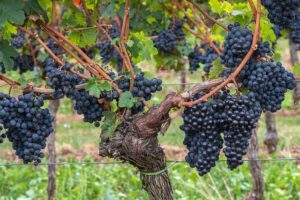
Pruning grapevines is a vital task to ensure optimal growth and fruit production. It is typically performed during late winter or early spring, when the vines are dormant and before new growth begins. The objectives of pruning are to regulate fruit production, to maintain the form and structure of the vine, and to remove dead or diseased wood. The method of pruning may vary according to the type of grapevine and the trellis system used, but generally, most grapevines benefit from spur or cane pruning.
Grapevines have several key parts that play crucial roles in their growth and fruit production.
- The trunk serves as the main structural support of the vine, connecting the root system to the vine’s above-ground elements. It’s a perennial part of the plant that grows thicker with age. The trunk will sometimes become diseased or damaged. If this happens just train a shoot up next to it and when it has matured remove the old trunk.
- Cordons are the arms extending horizontally from the trunk. They are often trained along wires in commercial vineyards for easy maintenance and harvesting.
- Canes are the year-old shoots that have matured and become woody. Canes are pruned annually to manage vine size and shape, as well as to promote healthy growth and fruit production.
- Shoots are the green, flexible stems that grow from buds on the canes, cordons, or trunk. They bear the leaves, tendrils, and clusters of grapes.
- Finally, spurs are short shoots that are pruned back to only a few buds. These buds will produce the shoots that bear fruit in the next season. Understanding these parts of the grapevine can aid in effective vineyard management and grape production.
Spur pruning involves cutting back the previous year’s growth to two to four buds, which will produce the current year’s fruiting canes. This is typically used for table grape varieties. On the other hand, cane pruning involves selecting one or two canes from the previous year’s growth to retain, and remove the rest. This method is commonly used for wine grapes. The grapes grow on the shoots put out by the one-year-old canes. You only want to keep enough to produce the next year’s shoots. Those shoots in turn will become woody canes that bear the next year’s fruit.
Failing to prune enough is the main cause of crop failure. The fruit won’t ripen without sunlight o it may be necessary to prune back leaf growth in the summer as well.
Trellising Grapevines
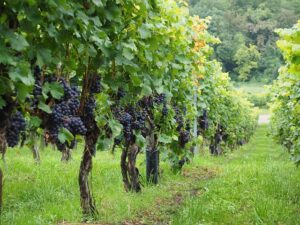
Trellising grapevines is equally important as it provides support for the plant, aids in disease control through improved air circulation, and improves exposure to sunlight, which enhances fruit quality. There are several trellis systems available, with each suitable for different vine types.
The Single Wire system is simple and inexpensive, ideal for vigorous, trailing-type grapevines. This system involves attaching a single wire to the end posts and training the vines along it. The Vertical Shoot Positioning (VSP) system is commonly used for high-quality wine grapes grown in cool climates. It involves attaching two wires, one above the other, with vines trained vertically between them. This system allows for better sunlight exposure and air circulation, leading to healthier vines and improved fruit quality. In contrast, the Geneva Double Curtain system, which involves two wires set widely apart, is great for extremely vigorous varieties, as it allows more sunlight on the vines. this involves training the vines vertically up to a center wire, then training the vine out to the outer wires with two canes on each wire, one going left one going right and then creating a “curtain” of foliage hanging down.
In addition to providing support and improving fruit quality, trellising also plays a crucial role in managing vine canopy and optimizing yield. By training the vines along a specific system, growers can control how much foliage and fruit is exposed to sunlight
Other trellis systems include the Smart-Dyson system, which uses multiple wires to create a “tent-like” canopy, and the Scott Henry system, which involves two layers of horizontal shoots. These systems are typically used for high-density plantings and advanced vine
The type of trellising system used should be chosen based on the growth habits of the vines and the local growing conditions. It’s important to remember that proper training of grapevines to the trellis system is crucial to maintaining the form and productivity of the vine.
For my few grapevines, a cattle panel arbor seemed the best solution. Even though it supposedly gives you poorer yields because of less sunlight penetration it’s easy to put up and cheap. Also it’s quite pretty!
Fertilizing Grape Vines
Fertilizing grapevines is a vital aspect of their overall care and maintenance. It’s important to note that grapevines generally do well in slightly acidic to neutral soils. Before fertilizing, conducting a soil test will give you an idea of the soil’s pH and nutrient content. This information will guide you in selecting the right fertilizer.
Generally, a balanced fertilizer like a 10-10-10 (Nitrogen-Phosphorus-Potassium) is used. However, if the soil test shows high phosphorus levels, a fertilizer with a lower phosphorus content might be used, such as 10-5-10. Apply the fertilizer in early spring before new growth begins.
To fertilize, spread the fertilizer in a 2-foot band along the grape row or around each vine in a 2-foot radius. Be sure to keep the fertilizer at least 6 to 12 inches away from the trunk to avoid possible fertilizer burn. After application, water thoroughly to help the fertilizer penetrate the soil.
Remember, over-fertilizing can lead to excessive vine growth, making the plant more susceptible to disease and reducing the quality of the grapes. Therefore, it’s important to fertilize judiciously and monitor the plant’s health throughout the growing season.
Common Grapevine Pests
Grapevines can become susceptible to a variety of pests, which can affect both the health of the vine and the quality of the grapes.
Grape Berry Moth: This pest targets the fruit directly, with larvae feeding on the berries. This can lead to crop loss and increased susceptibility to disease. You deal with this with the use of insecticides or by using pheromone traps to disrupt their mating and reproduction.
Grape Phylloxera: This tiny, aphid-like pest feeds on grapevine roots, causing them to swell and eventually die. A telltale sign of a phylloxera infestation is yellowing or wilting leaves. To prevent this pest, use resistant rootstocks or treat the soil with a systemic insecticide.
Japanese Beetle: These beetles can cause extensive damage to grapevines by feeding on the leaves, flowers, and fruit. They are most active during warm summer months and can be controlled through hand-picking or the use of insecticides.
Mealybugs: These are small, white, fuzzy pests that exude a sweet substance called honeydew, which can lead to the growth of sooty mold, affecting photosynthesis and the overall health of the grapevine. Mealybugs feed on plant juice, stressing the vine, and may also transmit viruses. They can be controlled by natural predators like ladybugs and lacewing larvae. In severe infestations, it may be necessary to use insecticidal soap or oil sprays. It’s crucial to inspect your vines regularly and act promptly to prevent extensive damage.
Grape Leafhoppers: Grape leafhoppers are tiny insects that feed on the undersides of grape leaves, causing them to turn pale or yellow and to eventually drop prematurely. This affects the overall health of the vine and, in severe cases, can impact the quantity and quality of the harvest. These pests reproduce rapidly in warm weather, leading to frequent infestations during the summer months. Control measures include introducing natural predators such as lacewings and lady beetles, or applying insecticides if the infestation is severe. Regular inspection is key to early detection and management of grape leafhoppers.
Common Grape Diseases
Just like any other plant, grapevines are susceptible to various diseases that can affect their growth and overall health. Some of the most common grape diseases include:
- Powdery Mildew: This fungal disease forms a white powdery coating on the leaves, shoots, and berries of grapevines, hindering photosynthesis and reducing fruit quality. It thrives in warm and humid conditions, making it prevalent in many grape-growing regions. To prevent powdery mildew, maintain good airflow around the vines, prune regularly to remove infected plant parts, and apply fungicides if necessary.
- Downy Mildew: Similar to powdery mildew, downy mildew is also a fungal disease that affects grapevines. It causes yellow spots on the leaves, shoots, and berries, which eventually turn brown and die. Downy mildew thrives in cool, damp conditions and can spread rapidly during periods of rain. Management measures include removing infected plant parts and applying preventive fungicides.
- Black Rot: This fungal disease affects grapevine leaves, stems, and fruits, causing them to turn black and shrivel up. It is common in warm and humid climates, and can significantly reduce the yield of a vineyard if left untreated. Control measures include removing infected plant parts, applying fungicides, and maintaining proper canopy management to promote airflow.
- Phomopsis Cane and Leaf Spot: This disease causes small brown or black spots on grapevine leaves and canes, leading to defoliation and reduced fruit quality. It thrives in warm and humid conditions, especially during periods of rain. To prevent phomopsis cane and leaf spot, ensure proper canopy management, prune regularly to remove infected plant parts, and apply fungicides if necessary.
- Pierce’s Disease: This bacterial disease is spread by insects and primarily affects grapevines in California and the southeastern United States. It causes leaves to turn yellow, wither, and fall off, ultimately leading to vine death. Currently, there is no cure for Pierce’s disease, so prevention is crucial. Measures include planting resistant varieties of grapevines and controlling the insect vectors that spread the bacteria.
- Grapevine Leafroll Disease: This viral disease causes leaves to curl and turn red, leading to reduced sugar production and poor fruit quality. It is spread by insects and can also be transmitted through infected plant material. Prevention measures include planting certified virus-free vines, controlling insect vectors, and removing infected plants immediately.
- Eutypa Dieback: This fungal disease affects grapevine wood, causing it to die back and reducing fruit production. It is spread through pruning wounds and can survive in infected wood for several years. Control measures include proper pruning techniques, avoiding pruning during wet weather, and removing infected vines.
- Crown Gall: This bacterial disease causes galls or tumors to form on grapevine trunks and roots, ultimately leading to vine decline. It is present in most vineyards but only becomes a problem when vines are stressed. Control measures include using certified disease-free planting material and avoiding root damage during vineyard operations.
- Fanleaf Degeneration: This viral disease affects the leaves, causing them to become distorted and discolored. It is spread by nematodes in the soil and can also be transmitted through infected plant material. Prevention measures include using certified virus-free planting material and controlling nematodes through cultural practices.
- Bunch Rot: This fungal disease affects grape clusters, causing them to rot and reducing fruit quality. It is common in wet weather conditions and can be spread by insects or carried over from the previous season on infected plant debris. Control measures include proper canopy management to improve air circulation, avoiding overhead irrigation, and removing infected clusters immediately.
Harvesting Your Grapes
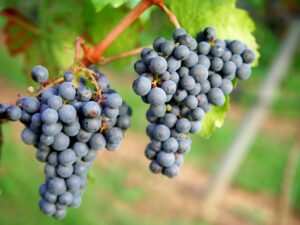
Harvesting grapes at the right time is key to ensuring the best quality of both eating and wine grapes. The grapes should ideally be rich in color and juicy when they’re ready for harvest. Test a few to be sure. The general harvest time fro grapes is late summer and early fall, depending on the grape variety and growing region.
Before harvesting, make sure the vines are dry to avoid any potential for mold growth. When picking the grapes, be gentle to avoid damaging them or knocking them off the vines. It’s also important to remove any damaged or diseased grapes as they can affect the quality of the remaining fruit.
Once harvested, grapes can be used for a variety of purposes such as eating fresh, making jam or jelly, or fermenting into wine. Each grape variety and growing region will have their own optimal time for harvesting, so it’s important to research and consult with local experts to determine the best time for your specific vines.
In addition to timing, the method of harvesting is also important
To harvest grapes, use clean, sharp pruning shears to cut the grape clusters from the vine. It’s best to cut the entire cluster rather than individual grapes, as this will help to prevent damage to the fruit and the vine.
Once harvested, grapes should be stored in a cool, dry place to help preserve their freshness. If you’re not planning to use the grapes immediately, they can be stored in the refrigerator for a short period of time. However, for the best flavor and quality, it’s highly recommended to use the grapes immediately after harvesting.
This article belongs to pineyriverhomestead.com. Published 9-29-23
Conclusion
In conclusion, the art of harvesting grapes is a delicate dance, where precision and timing intertwine to create the pinnacle of fruit quality. Each grape’s color, firmness, and taste, coupled with the climate and region, play a symphony that guides the optimal moment of harvest. But it doesn’t end there – gentle handling during this crucial period, swift utilization, and proper storage conditions are the secret ingredients to preserving taste and avoiding any flavor loss. Whether you’re a seasoned farmer or a passionate home gardener, unraveling these intricacies will unlock a world of possibilities. From savoring the sweetness of fresh grapes to creating delectable jams or mastering the art of winemaking, your grape harvest will flourish with newfound brilliance.
For more on gardening click here
If you are interested in permaculture click here.
If you are interested in winemaking check out my article how ot make wine
